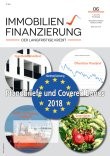Interest in energy efficiency finance has increased in recent years, driven largely by the successful conclusion of the United Nations Climate Change Conference (COP21) in 2015 and the ambitious efforts being undertaken at European-Union-level as a result. For its part, the European Union (EU) has set itself an overall 20 per cent energy savings target by 2020 and a 30 per cent target by 2030. It is widely anticipated that around 180 billion euro of additional investments a year is needed to reach the EU's 2030 energy efficiency saving targets agreed during COP21.
In search of incentives for building owners
Considering that the EU's building stock is responsible for 40 per cent of the EU's total energy use, and that the value of the European mortgage market is equal to 53 per cent of EU's GDP, there is huge potential to unlock the benefits of mortgage financing to support energy efficiency. Bridging these two worlds, which until recently have been operating in a largely disconnected manner, has the potential to deliver an effective way to tackle the challenges arising from climate change.
With this in mind, for approximately three years, the European Mortgage Federation - European Covered Bond Council (EMF-ECBC) has been working on the development of an "energy efficient mortgage" according to which building owners are incentivised to improve the energy efficiency of their buildings or acquire an already energy efficient property by way of favourable financing conditions linked to the mortgage. This mortgage financing mechanism is intended to be supported by a data protocol and portal to collect and access large-scale empirical evidence relating to energy efficient mortgage assets allowing a comprehensive analysis of derisking energy efficiency features.
The Energy Efficient Mortgages Initiative1), as the project is known, consists of two parallel projects, the "Energy efficient Mortgages Action Plan" (EeMAP) and the "Energy Efficient Data Portal & Protocol" (EeDaPP), and is funded via the European Commission's Horizon 2020 Programme.
Significantly, the Energy Efficient Mortgages Initiative represents the first time a group of major banks and mortgage lenders, as well as data providers, companies and organisations from the building and energy industries and the valuation profession have proactively come together to discuss private financing of energy effi ciency.
The Energy Efficient Mortgages Initiative was born from the realisation that: (i) banks, in financing the purchase of property, can play a game-changing role in supporting the EU's energy savings targets, by bringing energy efficiency into the conversation between banks and consumers by means of a standardised approach to the financing of energy efficient buildings/renovation, and (ii) by way of the Initiative, it would be possible to respond to increasing demand for "green" on the funding side of the mortgage business, by delivering a new asset class, an energy efficient mortgage, which could be used for the purposes of green bond and green covered bond issuance.
The ultimate success of the Project rests on the key assumption that energy efficiency has a risk mitigation effect for banks, by positively impacting borrowers' ability to service their loan thereby lowering the Probability-of-Default (PD) of the borrower (because there is more disposable income available) and that improved energy efficiency increases the value of the property, thereby lowering the loss for the bank in the case of default, i.e. the Loss-Given-Default (LGD).
Positive outcome could lead to lower capital requirements
Establishing a correlation between energy efficiency and PD and LGD provides a central business case for lenders to originate energy efficient mortgages, given the fundamental role of these risk parameters in the calculation of banks' capital requirements. If a positive effect in respect to the correlation can be established using largescale empirical evidence - as envisioned by the Project - the EMF-ECBC believes that the lower risk of energy efficient mortgages should be recognised in the regulatory framework in the form of a realignment of the capital requirements for these exposures. In turn, this would represent a strong incentive for banks and investors to play an active role in the energy efficiency financing agenda.
This alignment is also supported at EU level with numerous initiatives being pursued to bring into line the financial sector with the EU's commitments on climate change. As part of these efforts, the European Commission published an Action Plan2) on Financing Sustainable Growth in March 2018, which sets out the necessary steps for the financial system to contribute to the delivering the EU's new sustainable finance strategy, by introducing legislative proposals on how to integrate sustainability considerations into new and existing policy frameworks, with the first initiatives planned for the end of Q2 2018.
Data collection and analysis about to begin
Encouragingly, in its recently published Action Plan on Sustainable Finance, the European Commission specifically refers to the Energy Efficient Mortgage Initiative on page 9 (footnote 30) as a market initiative aimed at "demonstrating a correlation between energy efficiency in buildings and mortgage performance" and commits to considering the potential for a realignment of capital requirements for green assets. In this respect, the European Commission states that it "will consider all the available evidence on the link between energy effi ciency savings and mortgage loan performance".
Data collection and analysis with a view to establishing this correlation will begin in the form of an Energy Efficient Mortgages Pilot Scheme, which will be launched on the occasion of a large Energy Efficient Mortgages Stakeholder Event to be held on 14 June in Windsor, UK. The Pilot Scheme will be supported by an Energy Efficient Mortgage Product Framework3), which will be launched the same day, and which sets out high-level guidelines for mortgage lend ing, building performance assessment and property valuation. At the time of writing, more than 20 pioneering banks from across the EU have signed up to participate in the Pilot Scheme.
Significantly, the Project in general and the Pilot Scheme in particular will be supported by the design and delivery of a market-led protocol, which will enable the large-scale recording of data relating to energy efficient mortgage assets, via a standardised reporting template. The data will be accessed by way of a common, centralised portal, allowing for continuous tracking of the performance of the energy efficient mortgage assets, thereby also facilitating the tagging of such assets for the purposes of energy efficient bond issuance. As indicated, the datasets gathered as part of the Project are intended to allow for the linking between energy efficient features of a building, its value, and the loan performance, thereby creating a better understanding of the impact of energy efficiency on banks risk parameters as described above.
Looking at the Project from a broader perspective, the underlying risk assumptions also drive an incentive chain which provides an economic advantage to all stakeholders involved: borrowers, lenders and investors. In addition, the private investments foreseen will provide a flow of capital into the real economy and in doing so support privately held companies, for example small and medium sized enterprises (SMEs), engaged in renovation whilst encouraging innovation and stimulating start-ups in the field of energy efficiency.
A virtuous circle
As suggested above, the Project aims to consider and deliver additional synergies in the mortgage lending and funding value chain by delivering a new asset class, an "Energy Efficient Mortgage" which could be used for the purposes of green/energy efficient covered bonds issuance, creating a virtuous circle. While over the past few years, green and sustainable bonds have been a fast-growing capital market segment, the market for green and sustainable (covered) bonds is still in its infancy.
There is nonetheless reason to believe that the market has significant potential going forward, with a strong investor base for green/sustainable debt products having been observed, for example green covered bonds being heavily oversubscribed. There is therefore reason to believe that the Energy Efficient Mortgage Initiative will stimulate the growth of the green and sustainable covered bond market. In view of this, the ECBC has introduced a Sustainable Covered Bond Label on the ECBC Covered Bond Label website4), which facilitates the identification of green/sustainable covered bonds for market participating.
Project Partners & Deliverables
The Energy Efficient Mortgages Initiative will concretely deliver the following results by way of EeMAP and EeDaPP during the life of each Project (each 24 months, from May 2017 and March 2018 respectively):
1. The EeMAP Initiative - led by EMF-ECBC, Ca'Foscari University of Venice, RICS, the Europe Regional Network of the World Green Building Council, E.ON and SAFE Goethe University Frankfurt - will deliver the following five deliver ables: (1) Identification and summary of market best practices, (2) Definition of an energy performance indicators and a Building Energy Passport, (3) Identification of pre-requisites for the assessment of "green value", (4) Substantiation of correlation between EE & probability of default - portfolio analysis and (5) Definition and design of energy efficient mort gage, based on preferential finan cial conditions.
2. The EeDaPP Initiative - led by EMF-ECBC, Ca'Foscari University of Venice, CRIF, European DataWarehouse, Hypoport, SAFE Goethe University Frankfurt and TXS - will deliver the following five deliverables: (1) Identification and summary of market best practices within data systems, (2) Definition of energy efficiency reporting criteria, (3) Design and delivery of standardised data protocol and common centralised portal, (4) Data and substantiation correlation analysis and (5) Roadmap for system integration.
Note: The EeMAP and EeDaPP projects have received funding from the European Union's Horizon 2020 research and innovation programme under grant agreements n. 746205 and n. 784979
Notes
1) For more information about the project, please visit: http://eemap.energyefficientmortgages.eu.
3) Draft available here: http://eemap.energyefficientmortgages.eu/wp-content.




